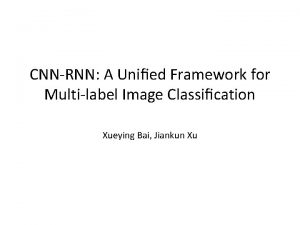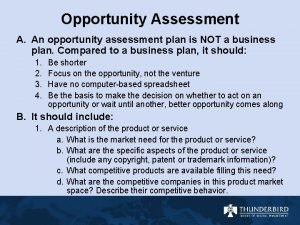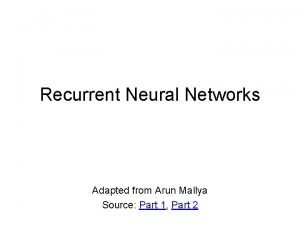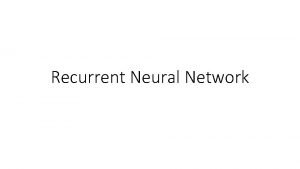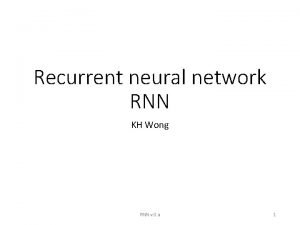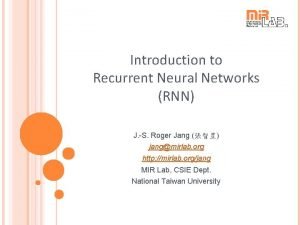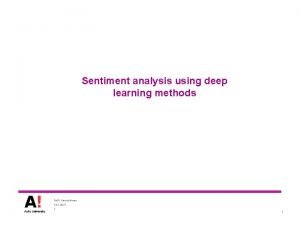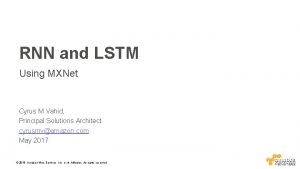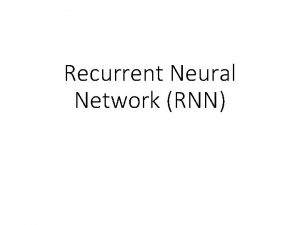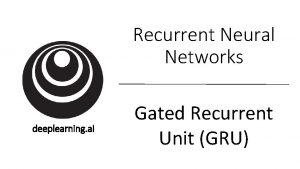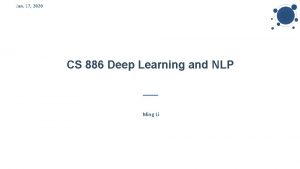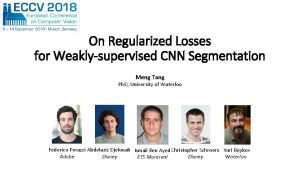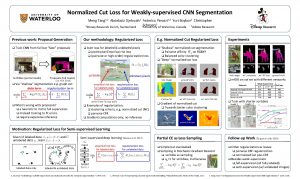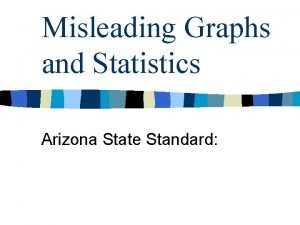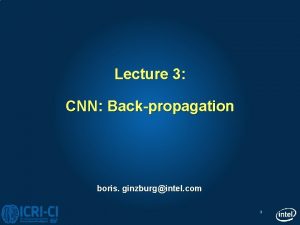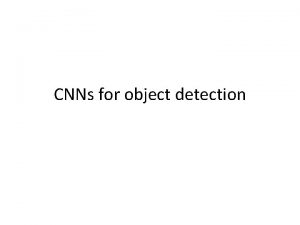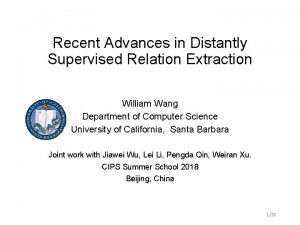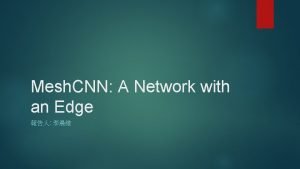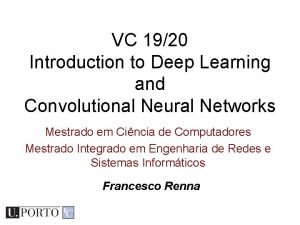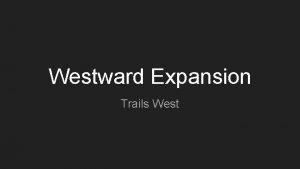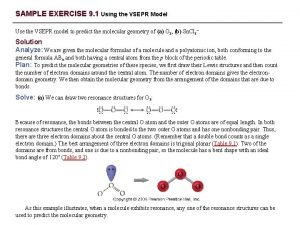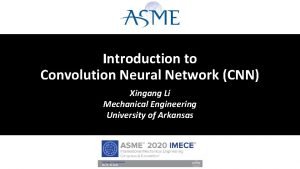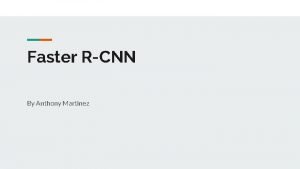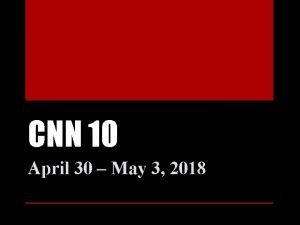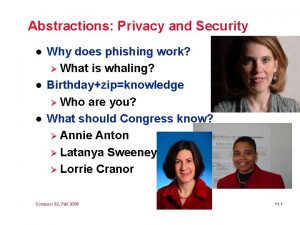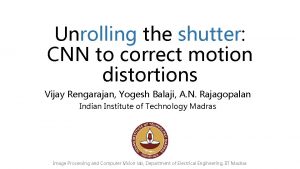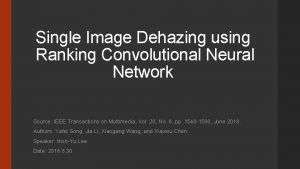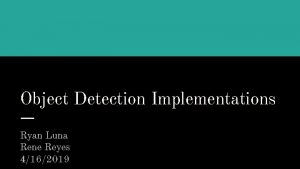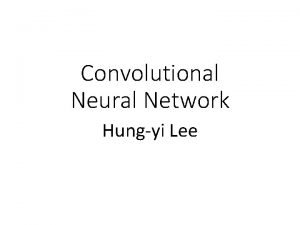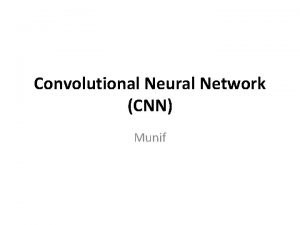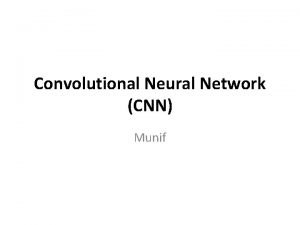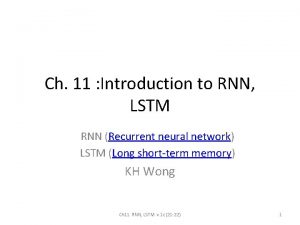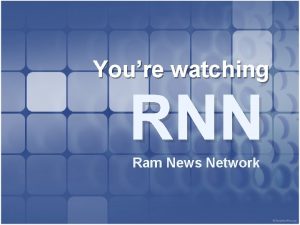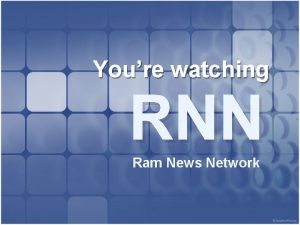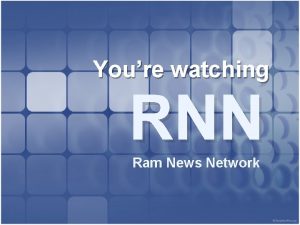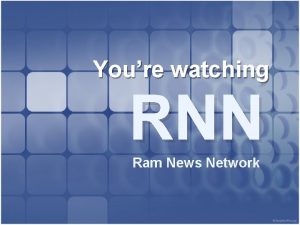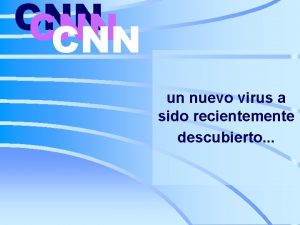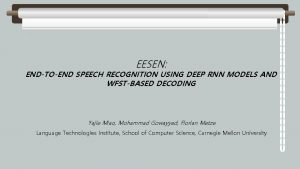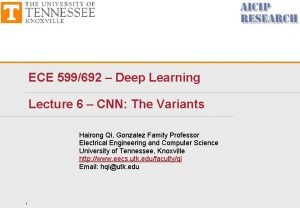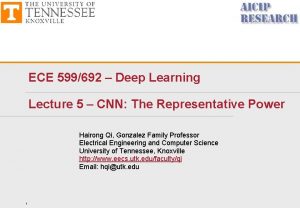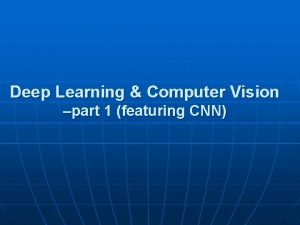Deep Learning Machine Learning CNN RNN Opportunity Machine















































- Slides: 47


• • Deep Learning , Machine Learning CNN RNN Opportunity


Machine Learning ≈ Looking for a (kernel) Function • Speech Recognition “How are you” f • Image Recognition • Playing Go f “Cat” f “ 5 -5” • Dialogue System f “Hi” (what the user said) (next move) “Hello” (system response)

Image Recognition: Framework A set of function f “cat” Model f 1 , f 2 � f 1 “cat” f 2 “money” f 1 “dog” f 2 “snake”

Image Recognition: Framework A set of function Goodness of function f Training Data f “cat” Model f 1 , f 2 � Better! Supervised Learning Tag/Label function input: function output: “monkey” “cat” “dog”

Image Recognition: Framework Step 1 A set of function Goodness of function f Step 2 f Training Model Pick the “Best” Function f* Training Data “monkey” “cat” Testing “cat” f 1 , f 2 � Step 3 “cat” “dog” Using f

Three Steps for Deep Learning Step 1: define a set of function Step 2: goodness of function Deep Learning is so simple …… Step 3: pick the best function

Variants of Neural Networks Convolutional Neural Widely used in Network (CNN) 卷積神經網路 image processing Recurrent Neural Network (RNN) 資料來源 https: //www. youtube. com/watch? v=Fr. KWi. Rv 254 g&t=938 s

Why CNN for Image? • When processing image, the first layer of fully connected network would be very large …… …… …… 100 Softmax …… …… 100 x 100 x 3 1000 Can the fully connected network be simplified by considering the properties of image recognition?

Why CNN for Image • Some patterns are much smaller than the whole image A neuron does not have to see the whole image to discover the pattern. Connecting to small region with less parameters “beak” detector

Why CNN for Image • The same patterns appear in different regions. “upper-left beak” detector Do almost the same thing They can use the same set of parameters. “middle beak” detector

Why CNN for Image • Subsampling the pixels will not change the object bird subsampling We can subsample the pixels to make image smaller Less parameters for the network to process the image

The whole CNN cat dog …… Convolution Max Pooling Fully Connected Feedforward network Convolution Max Pooling Flatten Can repeat many times

The whole CNN Property 1 Ø Some patterns are much smaller than the whole image Property 2 Ø The same patterns appear in different regions. Property 3 Convolution Max Pooling Convolution Ø Subsampling the pixels will not change the object Flatten Max Pooling Can repeat many times

The whole CNN cat dog …… Convolution Max Pooling Fully Connected Feedforward network Convolution Max Pooling Flatten Can repeat many times

CNN – Convolution Those are the network parameters to be learned. 1 0 0 1 0 0 0 1 0 1 1 0 0 0 1 1 0 0 Filter 1 -1 -1 -1 Filter 2 Matrix 1 1 1 -1 -1 -1 Matrix …… 6 x 6 image 1 -1 -1 -1 1 Each filter detects a small Property 1 pattern (3 x 3).

CNN – Convolution 1 -1 -1 -1 1 stride=1 1 0 0 1 0 0 0 1 0 1 1 0 0 0 1 1 0 0 6 x 6 image 3 -1 Filter 1

CNN – Convolution 1 -1 -1 -1 1 If stride=2 1 0 0 1 0 0 0 1 0 1 1 0 0 0 1 1 0 0 6 x 6 image 3 Filter 1 -3 We set stride=1 below

CNN – Convolution stride=1 1 -1 -1 -1 1 Filter 1 1 0 0 1 0 0 0 1 0 1 1 0 0 0 3 -1 -3 1 0 -3 0 0 1 1 0 0 -3 -3 0 1 3 -2 -2 -1 6 x 6 image Property 2

-1 -1 -1 1 CNN – Convolution stride=1 1 0 0 1 0 0 0 1 0 1 1 0 0 0 1 1 0 0 6 x 6 image -1 -1 -1 Filter 2 Do the same process for every filter 3 -1 -1 -1 -3 -1 1 -1 0 -2 -3 1 -3 -1 Feature -3 Map 0 -1 -2 -2 0 -2 -4 4 x 4 image 1 1 -1 3

CNN – Colorful image -1 -1 11 -1 -1 -1 -1 -1 111 -1 -1 -1 Filter 2 -1 1 -1 Filter 1 -1 -1 -1 11 -1 -1 -1 -1 1 1 0 0 0 0 1 0 11 00 00 01 00 1 0 0 00 11 01 00 10 0 1 1 0 0 1 00 00 10 11 00 0 11 00 00 01 10 0 0 1 0 0 00 11 00 01 10 0 1 0

Convolution v. s. Fully Connected 1 0 0 1 1 -1 -1 -1 0 1 0 -1 1 -1 0 0 1 1 0 0 -1 -1 1 0 0 0 1 0 1 0 convolution image 0 0 0 1 0 0 0 1 1 0 0 0 1 0 0 0 1 0 …… Fullyconnected 1

1 -1 -1 Filter 1 -1 -1 -1 1 0 0 0 1 0 0 1 1 0 0 6 x 6 image Less parameters! 7 0 : 8 1 : 9 0 : 0 10: … 0 1 0 0 3 … 1 0 0 1 1 1 : 2 0 : 3 0 : 4 0 : 13 0 : 0 14 : 15: 1 16: 1 … Only connect to 9 input, not fully connected

1 -1 -1 -1 1 Filter 1 0 0 0 1 0 1 1 0 0 0 1 1 0 0 6 x 6 image Less parameters! 13 0 : 0 14 : 15: 1 16: 1 … Even less parameters! 7 0 : 8 1 : 9 0 : 0 10: -1 … 0 1 0 0 3 … 1 0 0 1 1 1 : 2 0 : 3 0 : 4 0 : Shared weights

The whole CNN cat dog …… Convolution Max Pooling Fully Connected Feedforward network Convolution Max Pooling Flatten Can repeat many times

CNN – Max Pooling 1 -1 -1 -1 Filter 1 1 -1 -1 -1 Filter 2 3 -1 -1 -1 -3 1 0 -3 -1 -1 -2 1 -3 -3 0 1 -1 -1 -2 1 3 -2 -2 -1 -1 0 -4 3

CNN – Max Pooling 1 0 0 1 0 0 0 1 0 1 1 0 0 0 1 1 0 0 6 x 6 image New image but smaller Conv Max Pooling 3 -1 0 3 1 0 1 3 2 x 2 image Each filter is a channel

The whole CNN 3 -1 0 3 1 0 1 3 Convolution Max Pooling A new image Smaller than the original image The number of the channel is the number of filters Convolution Max Pooling Can repeat many times

The whole CNN cat dog …… Convolution Max Pooling A new image Fully Connected Feedforward network Convolution Max Pooling Flatten A new image

Flatten 3 0 1 3 -1 0 3 1 0 1 3 3 Flatten -1 1 0 3 Fully Connected Feedforward network

More Application: Playing Go Network 19 x 19 matrix 19(image) x 19 vector Black: 1 white: -1 none: 0 Next move (19 x 19 positions) 19 x 19 vector Fully-connected feedforward network can be used But CNN performs much better.

More Application: Playing Go Training: record of 黑: 5之五 previous plays 白: 天元 黑: 五之5 … CNN Target: “天元” = 1 else = 0 CNN Target: “五之 5” = 1 else = 0

Why CNN for playing Go? • Some patterns are much smaller than the whole image Alpha Go uses 5 x 5 for first layer • The same patterns appear in different regions.

Variants of Neural Networks Convolutional Neural Network (CNN) Recurrent Neural Network with Memory (RNN) 循環神經網路: 適用於時間序列預測的 LSTM 模型。 Long Short-Term Memory (LSTM)










My Target 預測股市隔天指數值: RMSE=100 Train set : 2013/01/08~2014/8/3 Test set : 2014/8/27~2017/7/23

預測股市隔兩天指數值: RMSE=110 Train set : 2013/01/08~2014/8/3 Test set : 2014/8/27~2017/7/23

預測股市隔三天指數值: RMSE=117 Train set : 2013/01/08~2014/8/3 Test set : 2014/8/27~2017/7/23
 Cnn rnn
Cnn rnn Deep learning vs machine learning
Deep learning vs machine learning Opportunity
Opportunity Cspnet
Cspnet Deep asleep deep asleep it lies
Deep asleep deep asleep it lies Deep forest: towards an alternative to deep neural networks
Deep forest: towards an alternative to deep neural networks O the deep deep love of jesus
O the deep deep love of jesus Tony wagner's seven survival skills
Tony wagner's seven survival skills Rnn
Rnn Rnn backward pass
Rnn backward pass Caption generation
Caption generation Vanilla rnn
Vanilla rnn Rnn gradient
Rnn gradient Pixel recurrent neural networks.
Pixel recurrent neural networks. Rnn types
Rnn types Vanilla rnn
Vanilla rnn Mxnet rnn
Mxnet rnn Filling
Filling Rnn andrew ng
Rnn andrew ng Single headed attention rnn: stop thinking with your head
Single headed attention rnn: stop thinking with your head Opportunity machine
Opportunity machine Normalized cut loss for weakly-supervised cnn segmentation
Normalized cut loss for weakly-supervised cnn segmentation Normalized cut loss for weakly-supervised cnn segmentation
Normalized cut loss for weakly-supervised cnn segmentation Misleading graphs cnn
Misleading graphs cnn Pooling layer backpropagation
Pooling layer backpropagation Convolutional neural network ppt
Convolutional neural network ppt Sliding window object detection
Sliding window object detection Cnn 10 september 10 2020
Cnn 10 september 10 2020 Cascade rcnn
Cascade rcnn Text classification with cnn
Text classification with cnn First neighbor
First neighbor Jay contoy cnn
Jay contoy cnn Vgg
Vgg Alex burns cnn
Alex burns cnn Cnn 10 worksheet doc
Cnn 10 worksheet doc Vsepr exercise
Vsepr exercise Backpropagation cnn
Backpropagation cnn Cnn
Cnn Yaniv altshuler
Yaniv altshuler Cnn
Cnn Cnn student news quiz
Cnn student news quiz Cnn.com
Cnn.com Cnn
Cnn Convolutional neural network
Convolutional neural network Mask r cnn
Mask r cnn Is cnn a feedforward network
Is cnn a feedforward network Concept learning task in machine learning
Concept learning task in machine learning Analytical learning in machine learning
Analytical learning in machine learning
